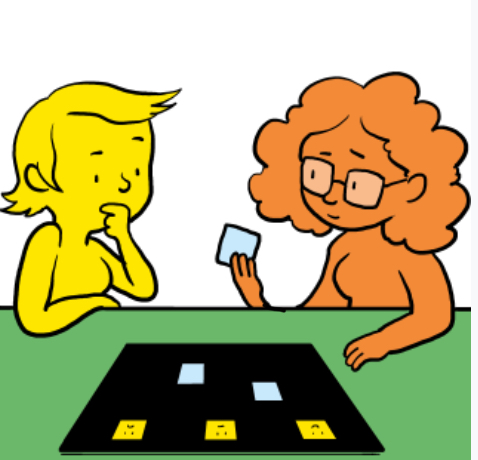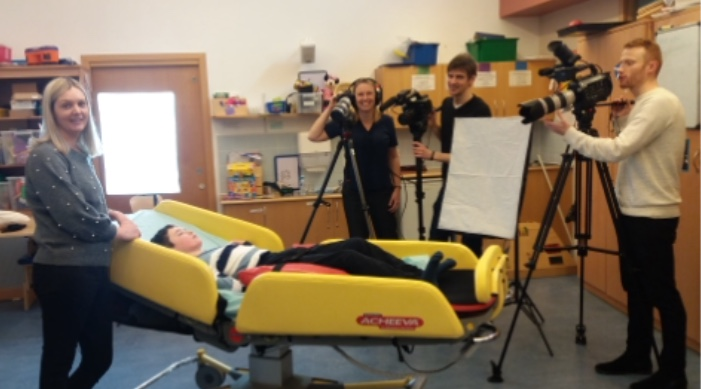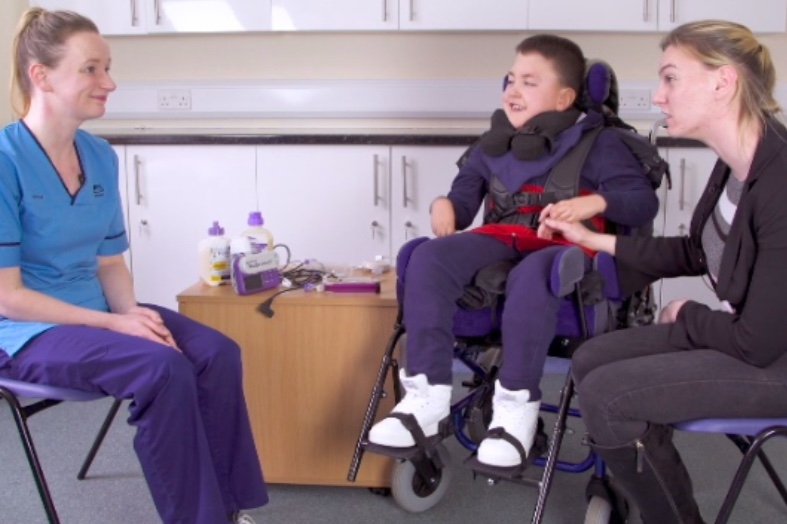Many thanks to Peter Just, Head of External Affairs, RCSLT and Padraigin O’Flynn, External Affairs Assistant, RCSLT for this blog describing the newly launched UK-wide RCSLT Survey, which includes free Talking Mats resources to support those with communication difficulties to have their voices heard.
Like many of you, the Royal College of Speech and Language Therapists (RCSLT) has been worried about the impact of COVID-19 on people with communication and swallowing needs. Based on what we’ve heard from our members, service user organisations and service users themselves we’ve been very concerned about how the UK-wide lockdown (March-June 2020) affected people’s access to the speech and language therapy they and their families and carers need.
To help us understand the issue better and to inform our response, we’ve just launched a UK-wide survey. Following consultation with service user organisations, the three key questions we’re asking are:
- How did lockdown affect your speech and language therapy?
- What impact did this have on you?
- What are your thoughts about the future?
From the start, we were clear: we wanted the survey to be as accessible as possible to as many people as possible, no matter how they communicate and no matter what their communication preference is. Over the past couple of months, we’ve worked with members to produce the survey in a range of accessible formats.
We’re particularly delighted that one of those formats is Talking Mats – and we’re very grateful to Lois and Laura for all their advice and support . As you will know better than anyone, the mats will enable people to give us their views and tell us how they’ve felt and are feeling. We are delighted the mats will provide people with the means to self-advocate – this will add a richness to the survey findings that they might otherwise lack.

We’ll be working with service user organisations to promote the survey to their networks. But we’d also really like your help too. Please share the survey and encourage as many people as possible to fill it out. The more voices we hear, the more stories we collect and the more responses we receive, the greater the impact of the survey findings will be.
Those findings, which we hope to publish early in the New Year, will be used to influence Governments, Parliaments and Assemblies across the United Kingdom. The case that will be making to ministers, officials and parliamentarians – that people must have access to the speech and language therapy they need – will be all the stronger for it being based on service users’ lived experiences. The very powerful testimony that the mats will provide will strengthen that case even further.
The survey is open until 5pm on Friday, 8th January 2021 and you can find more information about it here:
https://www.rcslt.org/learning/has-coronavirus-affected-your-access-to-speech-and-language-therapy
We hope you find the mats useful and if you had any queries or wanted any more information, please let us know. We look forward to working with you to help make a difference to the lives of people with communication and swallowing needs.
Peter Just, Head of External Affairs, RCSLT
Padraigin O’Flynn External Affairs Assistant, RCSLT
Many thanks to Marit Boot, founder of the charity What? Why? Children in Hospital for this guest blog sharing information about the fantastic family-friendly videos they make to help children understand hospital procedures.
As a mum, I know the worry when your child is ill and needs tests in hospital. It’s the not knowing what is wrong, understanding all the different tests and how to explain them to your child. That’s why I founded the What? Why? Children in Hospital charity to make family-friendly videos about hospital. So when we make a new video explaining a procedure in an easy to understand way, it’s the reaction from parents that makes it worthwhile. The relief, that they now have an idea of what will happen and that they can share the video with their child, it makes their preparation much easier. I want to share with you the story of one of the mums in our latest video. Louise talked to us about Rocco’s gastrostomy feeding tube operation.
“We didn’t have anything like the videos WWCIH make when Rocco first had the gastrostomy surgery. Being a parent in that position is daunting. You want to do what’s right for your child but there’s so much to take in. It isn’t always easy to remember what you’re told in the doctor’s office. So when we had the opportunity to help other worried parents and children by making this video, we jumped at it.”
Thousands of children go through a gastrostomy procedure in Scotland every year. It’s a major procedure and can be a complex idea to communicate to children and anxious parents. In the videos, medical specialists talk through how a gastrostomy feeding tube works, how the procedure is done and how parents should look after the feeding tube at home.
The videos are absolutely fantastic! With 32 doctors, nurses and specialists helping to deal with my son’s complex needs, it can be overwhelming to take in information they give to us. These videos are amazing for parents to find out information when they’re ready to absorb it. Even if that’s when you finally get to sit down at 2am.Gastrostomy is major surgery and we had to weigh the risks against the benefits for Rocco’s life. There was so much to take in, about the operation, the aftercare. At one point the doctor used a teddy to show how the tube worked – it was useful but didn’t give the full picture. The videos What? Why? have made cover what you need to know in a calm, thoughtful way. They will be a huge help to worried parents and will help them explain to their child what will happen and why. They should make as many videos as possible!”
We have 55 videos on our YouTube channel about tests such as MRI, CT, ECG, ultrasounds, allergy tests, breathing tests and sleep studies and we are always making new ones. They’re made in partnership with children’s hospitals in Scotland and are suitable for school-aged children, children with learning difficulties and autism as well as parents and carers from all cultural backgrounds and literacy levels. The videos have already been viewed by 2.8 million families across the world.
If you know a parent or carer who’s worried about their child going to hospital send them to our YouTube page (WWCIH charity), Facebook page (@wwcih) or our website: www.wwcih.org.uk
And if there’s a procedure you think we should look at next, get in touch! We’re here to help children and parents just like you!
info@wwcih.org.uk
Marit Boot, Founder What? Why? Children in Hospital, July 2019
Addressing the communication needs of people in youth justice is key to improving lives. The lack of attention to this is costly. On the 17th of April, we organised a seminar to look at the underlying issues and share good practice.
We were delighted with the collaborative mix of people attending. We had representatives from: the Scottish government, the NHS; Third sector organisations working in youth justice, the police, social workers, professional bodies, universities and social work.
Our thanks to Professor Richard Simpson for chairing the day and setting the tone by emphasising from the start that understanding communication is key to improving service delivery. Following his introduction a series of excellent and stimulating presentations took place creating a fusion of ideas and practice from Scotland and New Zealand.
- Kim Hartley Kean, head of the Royal College of Speech and language therapy Scotland office highlighted the current position in Scotland
- Sally Kedge and Alayne Mckee described the approach adopted by their organisation Talking Trouble in New Zealand.
- Jane Macer the therapeutic service co-ordinator from Starley Hall Fife described an whole system approach to embedding good communication practice within an organisation
- Yvonne McKeown and Sandra Polding Speech and Language Therapists working with young people in a NHS inpatient psychiatric unit in Glasgow shared some case examples.
In different ways the speakers brought up very similar themes:
- Communication can be treated glibly. There is a lack of understanding of what communication difficulties are and of the impact that they have on the lives of young people. These difficulties are often hidden and take time to identify. Lack of identification can have a huge impact on the future lives of young people.
- Finding ways to hear the young person’s voice is key both for the young person but also for organisations in order to deliver appropriate and effective care.
- Recognition of the intergenerational cycle and the importance of getting care and support correct so we break patterns and enable change.
- Providing collaborative solutions and understanding the breadth of communication will help services improve. However, given services often don’t know what they don’t know in terms of the impact of communication difficulties we have to find ways to express those solutions in language that those services can relate to and understand. Listening to organisations and exploring their processes by analysing the communicative demands of each stage can be a helpful way to start.
- Moving forward it is important to knock on open doors i.e. work with people who are receptive to recognising the impact of communication difficulties on young people and their lives but also find the strategic influencers who are sympathetic, in the words of our New Zealand colleagues ‘the aunts and uncles in the field’ who can help to promote the issue and raise awareness at a National level.
- You can’t explore the issue of trauma and adverse childhood experiences without certain precursor, building blocks being in place. This takes time and requires a constancy of approach.
- The importance of inclusive, visual tools becoming common place so that they are not used in isolation and in a vacuum.
- The challenge of supporting and nurturing a young person’s inner voice when they have significant difficulties with language.
- Lack of understanding of communication difficulties may lead to services responding to internalized behaviours that can lead to a fork in life; one way can send the young person down a route of offending behaviour services and the other mental health services.
- The solutions lie in partnership and collaboration between professions and services.
There were lots of creative ways of using Talking Mats that were shared. A couple of examples that stand out were
- Using Talking Mats with social workers to help them unpick what they already know about a young person’s language and communication. This approach helped them think about all the different aspects that contribute to communication and where the young person’s strengths and weaknesses lay e.g. non verbal communication , humour , word finding , understanding complex information, understanding simple information etc .
- Using Talking Mats to support a psychiatric assessment of a young person. One person used his Talking Mat to say he was hearing voices something he was unable to disclose verbally. In this case this enabled an accurate mental state assessment and non-custodial sentence.
I will leave the last word to a young man living in an inpatient unit to support his mental health, his words about communication difficulties are ‘They make you more vulnerable when bad stuff happens’ how true that is and this is why it is important we work together to improve services .
Next steps The community justice network met in the afternoon and were challenged to think about the opportunities and barriers in developing services – read the for blog that covers the afternoon ……… If you missed the seminar and want to join a multiagency network to discuss this and help take this forward in Scotland then please let us know .
Click to read the excellent presentations from the seminar
- CJSCENTalkMatsPresentation170418
- Talking Mats presentation 17 April 2018 Sally Kedge Alayne McKee TTANZ final
- TM seminar 04-18
- Talking Mats & Justice CEN April 2018 Draft
Talking Mats were delighted to be involved in the launch of Care Opinion’s Picture Supported stories at the Life Changes Trust Gathering in Perth Scotland this week. We have been working with Care Opinion for the past two years to develop this feature. This earlier Talking Mats blog describes the development process and this recent Care Opinion blog gives some examples of the feature in use.
However, in this blog, I want to reflect on two events I went to within a short space of time; the gathering in Perth on Monday and the Royal College of Speech and Language Therapists study day the previous thursday in Stirling . It felt to me like my two worlds colliding or maybe it was just my stars aligning ! At the RCSLT study there was a session on the public perception of Speech and Language therapy and how there is still much work to do in changing the myths that are spun and repeated about what Speech and Language therapists actually do . For as John F Kennedy said in 1962 ‘ the great enemy of truth is very often not the lie but the myth , persistent, persuasive and unrealistic ´ The National Allied Health Professional children’s lead, Pauline Beirne suggested to the study day that Care Opinion is a great web site for encouraging that sharing of stories. Then, strangely when I got back into the office there was a story waiting for me in my in box all about the positive experience of a parent involved in a Hanen programme in NHS Lanarkshire which reinforced that very message.
We know people relate to stories, stories resonate and have impact, they are easy to remember . Our drive in working in partnership with Care opinion was to support more people to tell their health and care stories by increasing accessibility . It was designed with and for people with dementia through funding from Life Changes Trust but anyone can use it and they are! It is great to see the stories coming in.
Through stories let’s celebrate the good, develop and improve practice and let’s use stories to challenge myths and educate. So use Care Opinion and try out the picture supported stories to share your experiences , tell other people ,spread the word and the picture supported story feature !
‘For every pound invested in the Talking Mats Keeping Safe resource and training there is a potential saving to services of £23.00’ .This was the findings of a cost benefit analysis carried out during the development phase of the Keeping Safe Talking Mat resource. A Cost-benefit analysis demonstrates the overall economic value of an intervention with numbers and evidence.
The Keeping Safe resource
The Keeping Safe resource is a visual framework that has been developed and trialled over 6 years in partnership and with funding from various organisations e.g. Survivor Scotland, Scottish government , Kingdome Abuse survivors project and NHS Fife
The Keeping Safe resource provides:
- A listening space for people with learning disability and communication difficulties to raise concerns and express their point of view.
- A structure for staff to find out what people are thinking about their lives, and raise issues that can be difficult to discuss.
A reflective practice training was developed and provided to over 700 staff to allow staff become familiar and confident with using the the resource
Findings of the cost benefit intervention
There is a significant financial advantage to services using Talking Mats. Analysis of six scenarios found that for each pound invested in the Keeping Safe training there is a potential saving to public services of £23.00. In learning disability services it is easy for costs to accelerate quickly. If services don’t respond effectively, challenging behaviours can escalate and relationships and placements are at increased risk of breakdown. Talking Mats can help provide staff with a comprehensive and accessible framework to help them listen to people who can find it difficult to articulate what is really going on for them e.g. issues of pain, relationships or levels of support. In this project 89% of Talking Mats resulted in staff learning new information about the person they were working with, even when they thought they knew them well. The Talking Mats framework provides a way to turn these points of views into actions that can be monitored and reviewed. It is these early interventions that not only save money but improve quality of life.
Cost benefit Process
With support from Inspiring Scotland a cost benefit analysis was done that examined the cost of the Talking Mats intervention and any resulting actions. 6 cases were chosen from over 100 detailed descriptions of how practitioners working with people with learning disabilities had used the resource. These descriptions represented a cross spectrum of people with learning disabilities in Scotland in terms of living situations e.g. living at home , in supported settings and an inpatients facility . They were also chosen to represent the comorbid conditions that often exist with learning disability e.g. autism, mental health and cerebral palsy. An alternative scenario was created and tested with critical friends as to the likelihood of what might have happened without the Talking Mats intervention. All the scenarios that were developed are available here 20180110 scenarios cost benefit The primary source of financial information and the subsequent calculations was the Unit Costs of Health and Social Care produced by the Personal Social Services Research Unit (PSSRU) 2015/16 . This contains detailed cost estimates for a range of services such as care placements, NHS services, social work, mental health, and family interventions. This analysis can only be illustrative as assumptions are subjective.
The findings from our final report 160512 Keeping Safe report 2013-2016 showed that effective use of the resource not only led to improvements to quality of life for individuals but that it can save services money. Book a place on our webinar and get the Keeping Safe resource 20180122 Keeping Safe Webinar or if face to face discussion is more your thing attend the advanced course in April 2018 – you get the resource with that booking too!
We have been working with Care Opinion to develop the accessibility of their site for people with dementia through picture supported stories.We are very grateful to Life Changes Trust for funding this partnership.
What is Care opinion ?
Care Opinion is an independent third sector organisation that supports feedback on health and care services. They promote honest and meaningful conversations between users of health and care services and their provider organisations. If you want to see how Care Opinion works then take a moment to watch this excellent video
Why is our partnership important?
Both organisations believe it is important that everyone can tell the story of their experience of using health and care services. This can be hard as there can be barriers to telling a first-hand account of an experience. These barriers can include
- difficulties with expression and finding the correct words
- difficulties with memory
- difficulties with writing or typing on a computer
Care Opinion is skilled and experienced in supporting feedback through their web platform and supporting health and care improvements through responding to and sharing that information . Talking Mats is skilled and experienced at supporting people with communication difficulties including people with dementia, to express their views. Partnership working between the two organisations has enabled a fusion of ideas and learning from each other to develop and action our vision of a care opinion platform that is more accessible and relevant to more people. This is particularly important when Alzheimer’s report ‘Fix Dementia Care: Hospitals’ reports that at least 25% of hospital beds are occupied by someone with dementia ,that they stay twice as long as other people over 65 and the experience of being in hospital is recognised as being a particularly frightening and confusing time.
What have we done ?
We have created an alternative picture story space on the Care Opinion website that is adapted from the work of Talking Mats. The picture story sets were made up after thinking about the topics that arose on the care opinion website .Then we worked with our expert advisor groups which included
- people with dementia,
- their carers
- staff
Our aim was to find a structure that would be comprehensive whilst keeping thing simple and not overwhelming .After a period of consultation and trialling the sets with people with dementia and their carers we have ended up with two sets one that covers the ‘environment’ and one that covers ‘care’
Who can use this and what support will they need?
We know people with dementia have a very diverse range of needs and that people will require different levels of support to give their feedback on the care opinion site ranging from technical support, scribing, to reducing number of pictures, to pre-preparation using paper pictures. Some people with later stage dementia may find it hard to use it to give their own feedback but hopefully, the pictures will mean that they will still be involved and understand some of the things being talked about if people are submitting feedback on their behalf.
We felt important that that the picture story space is an inclusive feature available to all to use if they want to. Whilst this feature was designed for people with dementia we have already had feedback that other people are finding it helpful.
The Picture Stories and Talking Mats
Several people have asked us if this is a Talking Mat and our response is that it is inspired by our work but it is different and for that reason we call it a ‘picture supported story’ .It is different partly, for technical reasons but also because the contexts in which people choose to give feedback will be varied e.g. some will do it by themselves, some supported by family and friends. Above all we want this to be freely available and recognise that that means people will use it in a variety of different ways some of which will surprise us!
We are still developing support materials and webinars to go along with the site to help people get the most from it.
However, there will be some people particular those with more severe communication difficulties who will need increased support to access the story space. Effectiveness for this group will improve if there is some preparation work to prepare their feedback .Using the paper set combined with the principles of Talking Mats to support communication will help. It is for this type of support we recommend attending a Talking Mats foundation training so people are confident and skilled using the pictures in a Talking Mats framework.
Soft Launch
For the last month the picture story feature has been available on the site and we are starting to get a range of stories on it. I particularly like the one that was submitted by a school pupil on work experience supporting a person with dementia to share his experience of going to an inter-generational quiz at the local nursery which had been a very positive experience for all involved.
So please give the site a go, submit your stories or encourage others to use it and please tell us how you got on. Click here to start
 Online training login
Online training login 






